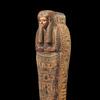Whitney Museum Acquires Archibald Motley Masterwork
- NEW YORK, New York
- /
- January 11, 2016

The Whitney Museum of American Art has announced the acquisition of Archibald Motley’s Gettin’ Religion (1948), the first work by the great American modernist to enter the Whitney’s collection. On view currently in the exhibition Archibald Motley: Jazz Age Modernist, which will close its highly successful run at the Museum on Sunday, January 17, Gettin’ Religion, one of the artist’s iconic Chicago street scenes, is among the Whitney’s most important acquisitions of recent years.
Motley first came to prominence in the 1920s during the early days of the Harlem Renaissance, the cultural flowering of African American art, music, and literature that extended beyond the New York neighborhood of its name to other cities, notably Chicago, where the artist spent most of his life. “For the last several years we have been working to bolster our holdings of works by key figures associated with the Harlem Renaissance and at the top of the list was bringing a major Motley painting into the collection,” noted Adam D. Weinberg, the Whitney’s Alice Pratt Brown Director. Motley had a long career and enjoyed recognition for his work early on—he was included in numerous exhibitions in the United States, including Contemporary Black Artists in America, shown at the Whitney in 1933—yet went through subsequent periods of struggle and obscurity. The current retrospective, Archibald Motley: Jazz Age Modernist, which was organized by the Nasher Museum of Art at Duke University and curated by noted art historian and Duke professor Richard J. Powell, has sought to reclaim Motley’s rightful place in American art history.
After Archibald Motley: Jazz Age Modernist closes, on January 17, the painting will soon go on view in The Whitney’s Collection on the seventh floor. “The Whitney Museum has long championed artists such as Edward Hopper and Reginald Marsh who captured the everyday life of the city in their works. We are thrilled that we can now hang this crucial acquisition, Gettin’ Religion, alongside such mainstays of the collection,” said Dana Miller, the Whitney’s Richard DeMartini Family Curator and Director of the Collection. “We expect that within a very short period of time it will come to be regarded as one of the icons of the Whitney’s collection.”
Motley took his primary artistic inspiration from the neighborhoods just south of Chicago’s main business district, a socially dynamic quarter known as the “Black Belt” and “Bronzeville,” both of which referred to the skin color of its inhabitants. The poet Langston Hughes described the neighborhood’s main leisure thoroughfare, known as “the Stroll,” as being crowded with “theaters, restaurants, and cabarets. And excitement from noon to noon. Midnight was like day. The street was full of workers and gamblers, prostitutes and pimps, church folks and sinners.”
The broad demographics and shifting cityscape of Bronzeville are evident in Motley’s Gettin’ Religion (1948), in which he captures the full spectrum of African American urban life on display. The street bustles with characters including amorous young couples, the elderly, musicians, and children. A wooden house on the far side of the street is bracketed by an apartment building and a market; from the windows and porch the residents voyeuristically regard the parade of life in front of them, mirroring the viewer’s perspective. Motley fuses this vivid narrative with coloristic invention; he bathes the nocturnal scene in blues and purples and the cool light emanating from an electric lamppost is echoed by the stars that dot the indigo night sky.
Gettin’ Religion was in the artist’s possession at the time of his death in 1981 and has since remained with his family. The Whitney purchased the work directly from Motley’s heirs.
Archibald John Motley Jr. (1891–1981) was a bold and highly original modernist and one of the great visual chroniclers of twentieth-century American life. Motley was born in New Orleans, but his family moved to Chicago when he was quite young, and he later became one of the first black artists to attend the School of the Art Institute of Chicago. His training there was academic, rigorously focused on the human figure, and steeped in European tradition. Motley’s sophisticated understanding of art history is especially apparent in his sympathetic portraits, but it was a history that he challenged and advanced with his raucous depictions of everyday urban life.
While Edward Hopper, Thomas Hart Benton, and Reginald Marsh became much more famous than Motley for their American scenes, he also developed and elucidated his own archetypes of place and people in this country, based on African American subject matter. As the work on view in Archibald Motley: Jazz Age Modernist eloquently attests, Motley rightly holds a place among the great American modernists. The artist created a far more daring visual language than many of his contemporaries, combining vivid narrative with dizzying spatial distortion and jarring hues to produce striking settings for characters of diverse racial backgrounds and social classes. And while his portrayals range from serene and august portraits to abrasive or outrageous caricatures, all were his instruments for addressing the poignancy, folly, and complexity of modern life.
















